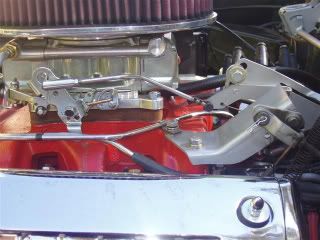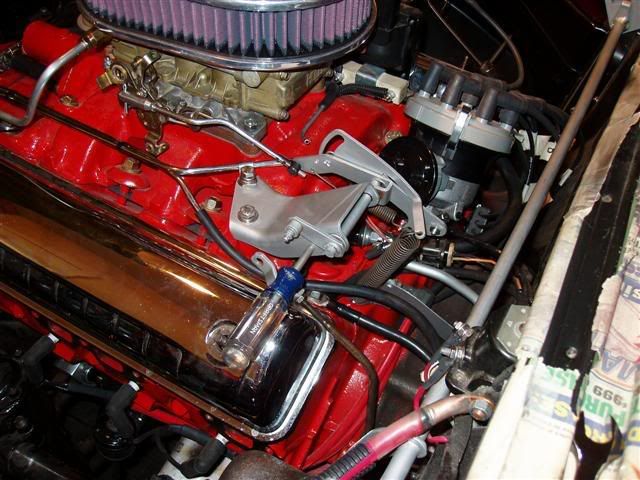|
Author
|
Message
|
|
Talkwrench
|
|
|
Group: Forum Members
Last Active: 4 Years Ago
Posts: 898,
Visits: 23.2K
|
|
|
|
|
|
PF Arcand
|
|
|
Group: Forum Members
Last Active: Last Year
Posts: 3.3K,
Visits: 238.8K
|
T.W. Did you have most of the linkage apart? Reason for asking is. I had the upper end of the lowerball end linkage apart on mine recently, to clean & lube it. When I put it back together and tried the gas pedal it was very stiff. Looked at it again & realized that there was two holes fairly close together horizontally, & I had bolted the upper pivot into the wrong hole..
Paul
|
|
|
|
|
Talkwrench
|
|
|
Group: Forum Members
Last Active: 4 Years Ago
Posts: 898,
Visits: 23.2K
|
By George I think he's got it !! Small things can make a big difference.. I think one of the main things I had problems with is the fact that I have a B manifold and the original A bell crank doesnt go straight on, you need to grind a piece off. When I first put it on I just made some spacers to lift it up. I did adjust everything to suit..seemed fine, but as with all things modified you get changes and sometimes a little is a lot. I fitted the bell crank again, ground the piece off and the alignment was better , before it seemed to align but when I pulled the 1/4" rod out it would spring up a little. I set the pedal height again, played and played with it, stuffed around with the springs this way and that even broke one at one point ! I realised that I was doing changes under the hood trying to get things working when its real important to have someone inside the car working the actual pedal so you can see the changes, thank you my dear wife.... I had to stretch the horizontal spring just so.. Anyway, the drive test with a few tweeks here and there seems to have got, dont think its perfect, I really have to smash the floor but I does go down a gear and a lovely noise is produced .. Wooo she goes...! Hope this may help someone else 
   
"Came too close to dying to stop living now!"
|
|
|
|
|
Talkwrench
|
|
|
Group: Forum Members
Last Active: 4 Years Ago
Posts: 898,
Visits: 23.2K
|
|
|
|
|
|
GREENBIRD56
|
|
|
Group: Forum Members
Last Active: Last Year
Posts: 1.7K,
Visits: 102.7K
|
Rob - The vertical spring is the throttle return - and the horizontal spring governs the force for overtravel movement in the kickdown slot. The whole lever assembly should be able to rotate without displacing the pin in the slot - until the carb reaches full throttle of the primary. The kickdown spring (horizontal) should be stiffest. On my outfits - with both the Holley 4160 and the Demon - the combined force of the spring in the carb - and that vertical spring at the rear - were too high, and the pin would begin to move in the slot before the carb reached full throttle. So you would be depressing the foot pedal - and no throttle change would result, just rotating the kickdown rod downward. Like pressing a sponge..... 
People have told me they successfully added spring force to the kickdown (horizontal spring) and got it to behave - but I haven't been that lucky. So mine has the bolt and washer seen in this photo to lock out the "over travel" slot - and I just shift it with the lever.

Steve Metzger Tucson, Arizona
|
|
|
|
|
Talkwrench
|
|
|
Group: Forum Members
Last Active: 4 Years Ago
Posts: 898,
Visits: 23.2K
|
|
|
|
|
|
GREENBIRD56
|
|
|
Group: Forum Members
Last Active: Last Year
Posts: 1.7K,
Visits: 102.7K
|
This shows the 'bird - don't know how closely it is allied to yours.... 
The hot idle gets set-up, then adjust the carb link with the "alignment tool" screwdriver stuck in the cross holes - then adjust the link down to the bellcrank to hold the throttle pedal up off the floor the right amount. My book says yours is to be 3-5/8 (93mm) off the floor. Then remove the tool. As the foot feed pedal goes down, the carb primary should pull to wide open before your foot reaches the floor. Once it reaches wide open (and stops) you should then be overpowering the kickdown spring to move the lever in the slot. This gets figured out without the kickdown rod connected - mine was off in the picture. You then pull up on the down rod of the kickdown - and adjust the clevis link to "just fit" onto the mating linkage pin. As it goes down - it increments the pressure upward in the comparator circuit. Adjusting the rod downward raises that pressure - without moving the throttle - which is where some mechanics get into trouble, because you can get it to "kickdown" without enough throttle to match.

Steve Metzger Tucson, Arizona
|
|
|
|
|
Talkwrench
|
|
|
Group: Forum Members
Last Active: 4 Years Ago
Posts: 898,
Visits: 23.2K
|
|
|
|
|
|
GREENBIRD56
|
|
|
Group: Forum Members
Last Active: Last Year
Posts: 1.7K,
Visits: 102.7K
|
Hi Rob - still tweakin' eh? The springs are rigged (as original) so that the carb will go to full throttle and reach it's stop - then the slotted kickdown portion of the linkage will begin to rotate further. It is an "over-travel" arrangement. Kickdown spring is stiffer than the throttle return spring. The prescribed distance under the foot pedal lets the linkage travel sufficently for everything to work. As the kickdown rod moves downward on its link - it is operating a pressure regulator in the transmission. This pressure is "compared" to pressure in another of the trans circuits and when they become equal - the trans drops a gear. Incrementing the rod up or down - raises or lowers the pressure. The Ford-O-Matic book suggests a point on the trans where an actual pressure guage may be utilized to monitor what the comparator is doing.

Steve Metzger Tucson, Arizona
|
|
|
|
|
Talkwrench
|
|
|
Group: Forum Members
Last Active: 4 Years Ago
Posts: 898,
Visits: 23.2K
|
|
|
|
|